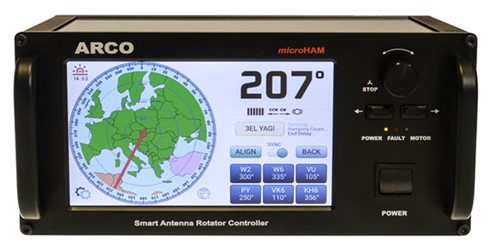When it was announced last year that WiMo of Herxheim, Germany, had named DX Engineering as the sole distributor of microHAM products in North America, the buzz among the amateur radio community was immediate, largely due to microHAM’s signature ARCO Smart Antenna Rotator Controller. One owner of the ARCO summed it up best when he wrote, “By far, hands down, there is nothing close to this controller.” Today, we’ll be taking a look at what makes the ARCO special.
- Let’s start with the obvious: the intuitive-to-operate seven-inch LCD screen that one DX Engineering operator appropriately described as “eye candy.” It features a colorful Great Circle azimuthal map, digital heading, and well-organized rotator control functions within easy reach. You can control the azimuth heading with the handy “Touch ’n Tune” feature while taking advantage of the four different radius settings, live gray line projection, multiple coloring options, and automatic day/night color schemes—a plus for VHF fans. All rotator settings, including compensation for power loss in the motor cabling, are menu-driven, without the need to open the cover.
- Built to work with virtually any rotator, including the DX Engineering RT4500HD model which is available in a combo with the ARCO, the flexible unit allows for manual, touchscreen, or remote control operation via Internet or Ethernet LAN. Local connectivity is possible through Windows 10, macOS, and Linux computers using a standard RS-232 or USB port, which do not require driver installations in most cases. Ethernet port over a local LAN or the Internet allows for the coupling of multiple ARCOs for automated stacks tracking, multi-directional beaming, and counter-rotation for rotating towers. Direct control of other rotators connected to any ARCO controller is possible whether they are on the same network or anywhere in the world, with an Internet connection.
- ARCO controllers are compatible with a wide range of absolute and relative sensors for rotator position feedback, including rheostat, potentiometer, reed contact, Hall sensor, and PWM sensors. When using a high-resolution sensor, positioning accuracy is within 0.1 degrees.
- The unit’s motor start-and-stop timing uses customizable, ultra-fine, gradual speed ramps which significantly reduce inertial stress to the rotator, antennas, and tower. This gradual speed control uses auto-adapting technology to adapt to the dynamically changing resistance caused by ice or wind.
- Its built-in linear power supply offers silent, interference-free operation. After completing an operation, the ARCO parks the antenna and disconnects all external lines to minimize the risk of static discharge and thunderstorms. The separate built-in power supply for the motor is turned off when not in use to avoid interference with other sensitive devices.
- The ARCO is available with a 200W power supply for standard rotators and a 400W model for larger rotators and can be easily adapted to existing installations.
For many more details, read this ARCO product review from DX Engineering customer/technical support specialist Michael, KI8R, who, among other things, praised the ease of performing firmware updates on the device, its large display that gives users all the information they need at a glance to know the current antenna position, and the presets that allow operators to easily and quickly point the antenna precisely where they want it. For an even deeper dive, here’s a link to the ARCO Smart Antenna Rotator Controller Manual


